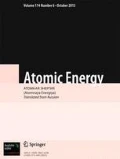Abstract
The characterisitics of the development of helium porosity in bcc and fcc alloys and structural steel after irradiation with 40-keV He+ up to dose 5⋅1020 m−2 at 20°C and subsequent annealing at 650°C for 1 h and 5 h are studied by transmission electron microscopy. It it found that under these conditions smaller bubbles with high density are formed in bcc than in fcc materials. It is shown that for an annealing time of 5 h higher porosity is formed in all materials, except nickel, than with 1 h annealing. This is due to the inflow of thermal vacancies from the free surface. The data obtained are discussed from the standpoint of the formation of various helium-containing complexes, their thermal stability, and the diffusion mobility of the matrix atoms.
Similar content being viewed by others
REFERENCES
B. A. Kalin, I. I. Chernov, A. N. Kalashnikov, and M. N. Esaulov, “Characteristics of the interaction of implanted helium with interstitial and substitution elements in nickel an diron,” Vopr. At. Nauk. Tekh., Ser. Fiz. Radiats. Povrezhd. Radiats. Materialoved., No. 1(65)/2(66), 53–79 (1997).
B. A. Kalin, I. V. Reutov, and I. I. Chernov, “Effect of carbon on the development of gaseous porosity in nickel saturated with helium up to 10−2 at.% during annealing at temperatures 500–1000°C,” At. Energ., 72, No.6, 559–565 (1992).
I. I. Chernov, B. A. Kalin, A. N. Kalashnikov, and V. M. Ananin, “Behavior of ion-implanted helium and structural changes in nickel-based alloys under long-time exposure at elevated temperatures,” J. Nucl. Mater., 271–272, 133–139 (1999).
S. Yu. Binyukova, B. A. Kalin, A. N. Kalashnikov, and I. I. Chernov, “Behavior of helium and development of gaseous porosity in the alloys Fe-C under ion irradiation,” Perspekt. Mater., No. 4, 50–57 (2002).
S. Yu. Binyukova, I. I. Chernov, B. A. Kalin, et al., “Formation of gaseous porosity in nickel alloys and structural steel under irradiation with helium ions,” At. Energ., 93, No.1, 32–40 (2002).
G. Kolk, A. Veen, and L. Caspers, “The interaction of He with C in α-Fe,” Delft. Progr. Rept. Ser. Phys. and Phys. Eng., 4, 19–28 (1979).
D. Reed, “A review of recent theoretical developments in the understanding of migration of helium in metals and its interaction with lattice defects,” Rad. Eff., 31, 129–147 (1977).
I. I. Chernov, A. N. Khalashnikov, B. A. Kalin, and S. Yu. Binyukova, “Gas bubbles evolution peculiarities in ferritic-martensitic and austenitic steels and alloys under helium ion irradiation,” J. Nucl. Mater., 323, 341–345 (2003).
L. N. Larikov and V. I. Isaichev, Structure and Properties of Metals and Alloys. Diffusion in Metals and Alloys. Handbook, Naukova dumka, Kiev (1987).
Author information
Authors and Affiliations
Additional information
__________
Translated from Atomnaya Energiya, Vol. 99, No. 2, pp. 115–120, August 2005.
Rights and permissions
About this article
Cite this article
Binyukova, S.Y., Chernov, I.I., Kalin, B.A. et al. Formation of Helium Porosity in Different Materials during Post-Radiation Annealing. At Energy 99, 550–555 (2005). https://doi.org/10.1007/s10512-005-0245-z
Received:
Issue Date:
DOI: https://doi.org/10.1007/s10512-005-0245-z



